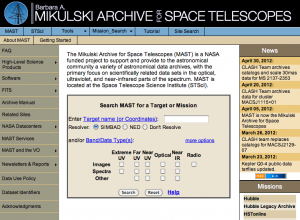This is a guest post from Rick White who is an astronomer at STScI. He is the Principal Investigator for MAST. This is the first of a planned series of articles about using MAST.
 The newly re-christened Mikulski Archive for Space Telescopes (MAST) is NASA’s archive center for ultraviolet, optical, and near-infrared data. MAST includes data from 15 NASA telescopes. Active missions include Hubble, Kepler, GALEX and XMM-OM. We have data from many legacy missions and also host the Digitized Sky Survey and the Guide Star Catalogs. More than 1000 papers were published last year using MAST mission data, and a large majority of those papers were archival publications unrelated to the original proposal that collected the data.
The newly re-christened Mikulski Archive for Space Telescopes (MAST) is NASA’s archive center for ultraviolet, optical, and near-infrared data. MAST includes data from 15 NASA telescopes. Active missions include Hubble, Kepler, GALEX and XMM-OM. We have data from many legacy missions and also host the Digitized Sky Survey and the Guide Star Catalogs. More than 1000 papers were published last year using MAST mission data, and a large majority of those papers were archival publications unrelated to the original proposal that collected the data.
MAST provides a variety of tools and interfaces for searching and retrieving data, many of which are probably already familiar to AstroBetter readers. These articles will describe some less widely known features of MAST. In future articles we’ll write about the Hubble Legacy Archive, GALEX and Kepler tools, community-contributed High Level Science Products, and the new MAST portal (scheduled for rollout at the May 2012 AAS meeting). We welcome suggestions for topics you’d like to see included.
MAST has custom search pages for all our different missions, and many of our users go directly to the Hubble data page. You might not have noticed that there is a multi-mission search form right on the MAST home page. Put in a target name or position to search the data for all the MAST missions. You can download or preview data from the results page. Note that this multi-mission search limits the number of results returned for any particular instrument to 10 datasets, so pay attention to the note at the top that says “10 rows displayed, but 36 are available”. If you click the title line for the results section (e.g., HST:ACS-IMAGE), it takes you to a search form that is already filled out for the target you requested. You can add additional constraints to the search if desired, then do Search to get the complete list of results.
The MAST form interfaces are convenient if you have only a few targets to search, but if you have a list of targets you’ll definitely want to use scripts. The MAST search functions are accessible through web services. MAST of course offers standard VO services including cone searches, simple image access and simple spectral access. The MAST services web page gives examples of the use of all these services.
But you might not realize that the MAST web services are much more flexible than the VO protocols. Hate XML and want the results as comma-separated values or in JSON? Add outputformat=CSV or outputformat=JSON to your query. Want to search using a target name instead of a position, or to use some old B1950 coordinates? There are optional parameters for that. Want to do an all-sky HST data search restricted using the exposure time, filter, or start time, any of the other parameters available on the HST search form? Check out the list of mission-specific HST parameters.
Finally, you don’t have to start your search from a list of targets or observation characteristics. The MAST Bibliography Search allows searches for papers that use MAST data; the HST Bibliography Search provides even more Hubble-specific options. Get a list of all the papers that have used ACS data (there are 2805 at this writing), or find the IUE papers with “radio” in the title. When you use this tool, the results include a Data link that lists the MAST datasets that were used and a link to the article in ADS. You can also search starting from ADS by requiring HST or IUE data links (which are provided to ADS by MAST), but the MAST interface provides more flexibility.
In the future we plan to use the paper titles and abstracts, along with proposal abstracts, to build a science keyword index for the MAST data. When coupled with data and publications from other missions and an onotolgy of astronomical terminology, this will enable a flexible and powerful interface to search for data based on scientific concepts (e.g., “gravitational lensing”) rather than specific targets.
Hi,
Nice to see this post! Are there any plans to implement a TAP service into the MAST archive (e.g. similar to http://simbad.u-strasbg.fr/simbad/sim-tap)? What about returning queries as JSONP so developers can create robust client-side web applications without the need of a proxy server to reformat the JSON response?
Looking forward to the follow up articles!
Cheers,
Amit
Hi Amit,
We are working on a TAP service; currently we are developing a standard data model that incorporates all of our missions, and we plan to have a TAP interface to that combined database (which would be easier to use than a lot of separate TAP services).
Thanks for the suggestion of a JSONP query format. I used JSONP myself in Javascript access to some of the Hubble Legacy Archive web services, and I agree it can be very useful. We should be able to add that pretty quickly.
Cheers,
Rick White